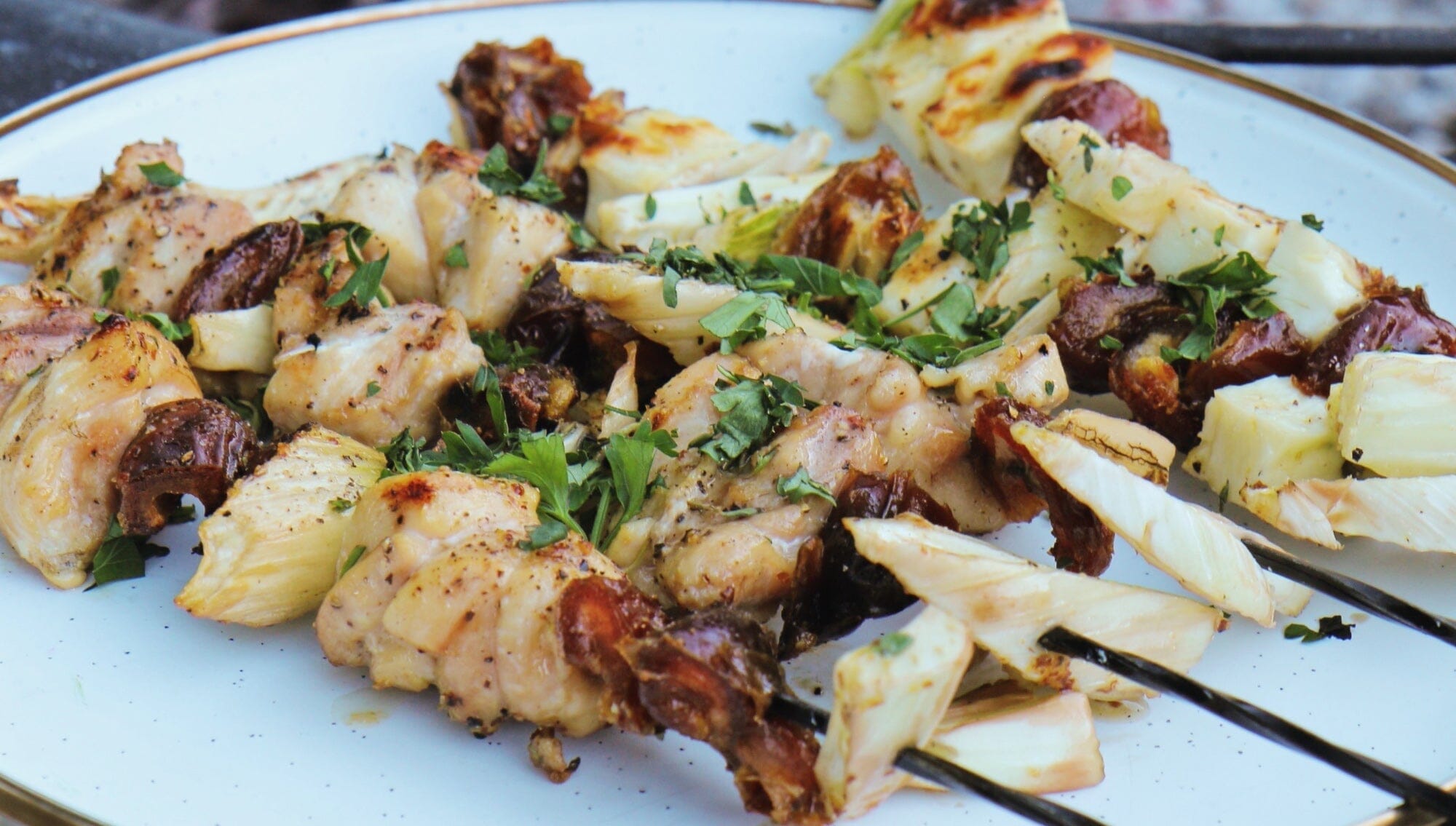Recipe by Chef Kevin O'Connor
Photos by Mike Battey
⋯ Featuring Hog Island ⋯

After grabbing provisions at Hog Island we headed out to the beach with the Fire Pit, Grill Grate, firewood, and an ice chest full of locally sourced provisions.

| The Fire Pit allows me to safely have a fire to cook on and enjoy with friends just about anywhere, while the compact folding Grill Grate fits in just about any bag and turns any fire into a cook-up. |

As soon as we lit the fire, the leeks were in the pit with it starting their journey as I set out on mine: looking for sea kelp to wrap the fish in.


| Heirloom tomatoes picked up along the way from a farm stand will lend the perfect amount of fresh acidity to the rich and fatty leek cream. A frosty bottle of chardonnay emerges from the ice chest, officiating our fireside cook-up on the beach. |


How to Make
Halibut Steamed in Sea Kelp
with Charred Leek Cream & Heirloom Tomatoes
Serving: 4 | Prep Time: 30 min + fire prep | Cook Time: 30 min | Total Time: 1 hour
Ingredients
- 1.5 pounds Halibut, cut into 4 portions
- 4 eight to ten inch sheets of dried kombu or gathered strips of fresh bull kelp, giant kelp, and/or kombu
- Butcher’s twine, soaked in water
- 1 yukon gold potato
- 1 pint heavy whipping cream
- 1 bay leaf (optional)
- 4 medium-sized whole leeks
- 1 lemon
- 12-16 sprigs of thyme
- Salt to taste
- Extra virgin olive oil (EVOO)
- 3-4 heirloom tomatoes
- 1 tablespoon light miso
- Cracked pepper
- 2 tablespoons fresh dill, chopped
Instructions
- Start (at least) a two foot fire in the Fire Pit with a hardwood like oak/almond or ignite a heaping chimney’s worth of high-quality charcoal. While the fire is burning down to a coal bed, set up your kitchen and get to prepping. Lay the leeks next to the fire to get things started.
- Dice the potato into small cubes and put them in a saucepan with the pint of cream. Place the cream over or next to the fire to bring up to a boil then move the saucepan to a spot that allows it to simmer. Season the pot with a few cracks of black pepper, a bay leaf and a pinch of salt. Stir occasionally while preparing the halibut.
- Lay four squares of hydrated kelp down on a large tray or cutting board and place each portion of halibut in the center. Dress each halibut portion with a drizzle of EVOO before seasoning with a liberal pinch of salt. Adorn each portion with a few sprigs of thyme and a lemon slice. Wrap the halibut with the kelp and tie it off with a few pieces of twine. It doesn’t have to be pretty, as long as the halibut isn’t exposed. Be sure to not use so much seaweed that you can’t feel the fish for doneness. Place the halibut parcels on the grill grate above the coals.
- Continue turning the leeks and allow the outside layers to char significantly before bringing them up to the elevated grill grate above the coals to continue cooking until soft. Once the leeks are charred and softened, transfer them to a cutting board. Cut away the tops, trim the bottom, and slice out the cooked, un-charred, inside layers. Roughly chop the inside layers of the leeks before adding them to the saucepan with the potatoes and continue simmering.
- Turn the halibut parcels and check the underside to ensure they’re all cooking at an even pace. Rearrange the parcels as needed and flip once the kelp starts to darken (10-15 minutes). Repeat this process on the other side and continue cooking until the fish feels firm when squeezed gently through the kelp. You’ll see liquid bubbling from the seams. Remove the parcels from above the coals and allow them to rest while you prepare the tomatoes and herbs.
- Slice the heirloom tomatoes into bite size pieces before giving them a drizzle of EVOO and a sprinkling of salt. Roughly chop the dill and set aside in preparation for the halibut.
- Check the potato and leek cream; it should be thickened, a few shades darker, and have a more homogenous consistency. Check for seasoning and adjust with salt and pepper if needed.
- Cut the twine and gently pull away the seaweed to expose the cooked halibut. Dress the halibut with an additional drizzle of EVOO, a squeeze of lemon, and a scattering of the fresh chopped dill. Spoon the leek cream into four bowls before placing the dressed halibut on top. Finish the bowls with a scattering of tomatoes.
- Enjoy Immediately -
ABOUT
Chef Kevin O'Connor
Raised in the Sierra Foothills, Kevin developed a love for gathering, hunting, foraging, and cooking at a young age. Starting in fine dining at the age of fourteen, the first twelve years of his career were spent in some of California’s best restaurants, while the past five years have been spent traveling the world with knives in tow. No matter the venture, Kevin strives to find a true connection to the food he cooks and the places it comes from. An avid outdoorsman and adventurist, he prefers an open fire to a traditional kitchen, cooking from the heart with a deep respect for seasonal ingredients.
Hog Island
Hog Island believes in growing oysters for future generations to come. That’s why their day-to-day operations include investing in sustainable farming and business practices; working with leading scientists to measure, understand and share the impacts of changing ocean conditions; and collaborating to help grow a shellfish industry that is sustainable for our coastlines, our communities, and our futures.
Hog Island is california-based with seven restaurant and purchasing locations and a direct-to-consumer online store. Learn more and purchase oysters online here.




